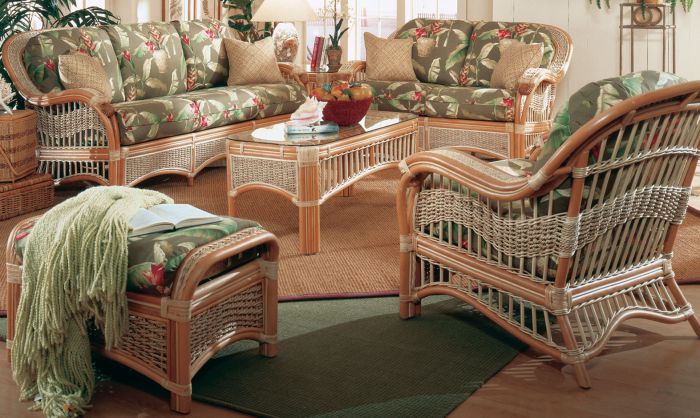Shop by Category
Enduring Beauty of Natural Rattan Rattan cane furniture is always in demand for its beautiful appearance and its strength. Often confused with bamboo, it has distinct characteristics that make it easy to recognize. Among its amazing features, rattan can be bent into any shape, used to design decorative spindling and sliced to create wraps that are glued in place as bindings. Once dried, rattan is suitable for staining or painting but is just as exquisite and hardy in its original state. Furniture made of rattan can be topical in appearance, and it easily adapts to other styles including country, Victorian, cottage and even modern. What is Rattan? Rattan is a member of the palm family with about 600 species found throughout tropical habitats. Only four of those species are used to make furniture. Palms in the larger sense can develop as trees, shrubs and vines. This falls into the vining category with stems that can reach lengths of several hundred feet. Known as armored vines, the outer layer develops thorns and whip extensions that clamp onto trees for support. The vines cause no harm and they grow quickly, which makes them even more desirable than wood in some areas. The majority of this material comes from Indonesia, but cane for furniture also comes from other areas of Southeast Asia as well as from Africa and Australasia. Unlike bamboo, which has a hollow core, the rattan definition in short is the material is a solid core species. By removing the outer layer, it can be used in a variety of ways. Steamed, bent and dried, it retains its exceptional strength. Bamboo poles are always straight and typically use bindings to hold frames together. How Rattan is Harvested Rattan grows wild but is also planted in select areas for controlled, sustainable harvesting. Gathering the thorny vines is tedious as they wind through dense rain forest growth. Typically, villagers work in teams climbing trees and chopping vines into workable lengths up to 15 feet. They also strip away the thorny outer layer with machetes. Smaller vines may receive a rinsing and then smoking for drying before bundling and toting out of the forest. Larger-diameter vines, stacked in piles, sit under a tent while drying over smoky fires. Grades of Rattan Rattan receives A, B or C grading based on appearance. Grade A is sanded smooth and is without surface flaws or color variations. Grade B may exhibit some surface color variances but will still retain a somewhat smooth surface. C grade material may exhibit some minor splits along with greater color variations and the appearance of exposed hairy strands. Lower grading does not affect strength. Different Processes in Using Rattan Once dried, rattan becomes solid poles for framing or with stripping and slicing turns into wicker and spindles. Bent through a process of steaming and then sitting in vises or forms for about 24 hours, can adapt to a variety of shapes. From intricate curlicues and scrolls to curved arms and coiled bases, the versatility of this material takes on amazing shapes and styles. Poles for furniture framing are generally about 1.5 inches or more in diameter. Rattan Cane Strands used for open spindle weaving come from the core and, through a shredding process, are round in shape. Rattan cane is shaved and then laid flat to cut into strips. Denser wicker weaves utilize flat strands for furniture seats, backs and sides. Bindings, also called peel wrap, come from the tougher exposed outer layer that is left after thorns are shaved away. Rattan furniture or combination pieces with wood framing will last longer when used indoors. Some of our furnishings include optional sealants for covered outdoor areas. | |